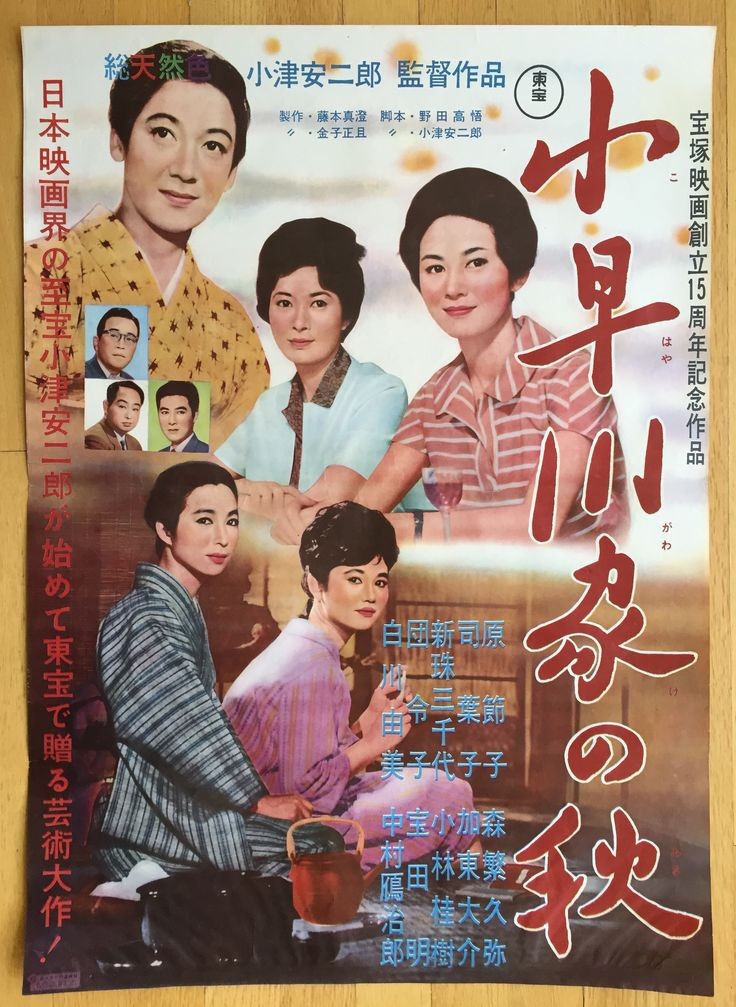
こんにちは。英語の翻訳を始めてから、といってもGoogleの自動翻訳ですが、自然とブログに取り上げるテーマも何故かグローバルなものの方が良いと勝手に思って、日本の映画監督の中でも世界的に黒澤明、溝口健二と並んで評価の高い小津安二郎について書いてみます。僕が初めて観た小津映画は「お早よう」(1959)でした。特徴的なローポジションのカメラアングルとイマジナリーラインを無視したカットバックで描かれる日常風景は、僕の中にとても鮮烈な印象を残しました。書きたいことが沢山あって何から書けば良いか迷っていますが、思いつくままに書いてみます。
Hello. Since I started translating English, it is Google's automatic translation, but I thought that it would be better for the theme to be taken up in the blog to be global for some reason, and Akira Kurosawa Mizoguchi Kenji is one of the Japanese film directors worldwide. I will write about Yasujiro Ozu, who is highly evaluated along . The first Ozu movie I saw was "Good Morning" (1959).The everyday scenery drawn with the characteristic low-position camera angle and the cutback ignoring the imaginary line left a very vivid impression on me. I have a lot of things I want to write and I'm wondering what to write, but I'll try to write as I can think of.
まず「小早川家の秋」(1961)について書く前に小津安二郎の映像の持つ特性について幾つか書いておきます。この文章を書くに辺り小津安二郎について調べていると、以前にも調べていた同じく小津安二郎の「風の中の雌鳥」(1948)について映画監督の黒沢清が登場人物が全員死んでいるようにしか見えない、という趣旨の発言をしていたことを思い出しました。詳しくは正清健介の「小津映画におけるゾンビ」というPDFに詳しく書かれていますが、「風の中の雌鳥」の最後の場面に妻が階段から落ちるというシーンがあります。結果的には妻は無事だった、という結末になっていますが、階段から落ちてしばらく動かない人間がのっそり起き上がるのは演出から考えれば完全に死んで生き返っています。関係ない話ですが、黒沢清はかなりこのシーンに影響を受けているようで「トウキョウソナタ」(2008)にも家族の再生という意味でこの演出が使われていました。
First, before writing about "The End of Summer " (1961), I would like to write some of the characteristics of Yasujiro Ozu's images. When I was researching Yasujiro Ozu around the time I wrote this sentence, all the characters of the movie director Kiyoshi Kurosawa died about Yasujiro Ozu's "A Hen in the Wind" (1948). I remembered that I was making a statement to the effect that it only looked like this.The details are described in detail in the PDF "Zombies in Ozu Movie" by Kensuke Masakiyo, but there is a scene where my wife falls down the stairs in the final scene of "A Hen in the Wind". As a result, my wife was safe, but the fact that a person who has fallen down the stairs and hasn't moved for a while rises up quietly is completely dead and alive from the perspective of the production. Although it has nothing to do with it, Kiyoshi Kurosawa seems to have been influenced by this scene, and this production was also used in "Tokyo Sonata" (2008) to mean the rebirth of his family.
小津安二郎の映像は非常に抑制されていて禁欲的です。映像技法も完全に完成していて、監督の意識が映画全体を支配しています。その中で演じる俳優は自然と演技の自由度が無くなります。ここから先の話に繋がりますが、つまり登場人物に全く生気がありません。皆思ってもいないことを義務のように喋っているように見えます。しかし演技にはとてもリアリティがあり、喜怒哀楽もちゃんとあります。そのアンバランスさが僕は怖く感じました。海外でこの能面のような顔で宙空を見つめながら身動ぎせず向かい合う会話の場面がどういう風に理解されたのかとても気になります。ある意味でこの演出は日本的ではあります。日本語は元々身振り手振りが少なくまた英語のようにアクセントがない言語なので、淡々と呆然と喋ることにそれ程違和感は感じません。また感情表現が苦手な民族であることも起因しているかもしれません。
Yasujiro Ozu's footage is highly suppressed and austere. The film technique is also completely complete, and the director's consciousness dominates the whole movie. The actor who plays in it naturally loses the freedom of acting. From here on, it leads to the story, but in other words, the characters are completely dead. He seems to be obliged to do something he never thought of.However, the acting is very real, and there are emotions and emotions. I felt scared of the imbalance. I am very curious about how I understood the scene of the conversation facing each other without moving while staring at the air with this Noh mask-like face overseas. In a sense, this production is Japanese. Since Japanese is originally a language with few gestures and no accent like English, it doesn't feel so uncomfortable to speak in a daze.It may also be due to the fact that they are not good at expressing emotions.
とりあえず書きたいことは書いたので後は観ていて気になったことを書きます。映画の中で画廊が出てきますが、その中に僕の好きな高山辰雄と東山魁夷の絵画が飾られていて、嬉しかったです。あと繰り返しの台詞が多かったです。映像としては不気味な印象ですが、話は凄く平和なもので、父親と娘とその旦那の微妙な力関係や、家族の目を盗んで家を抜け出す父親がコミカルに描かれていたりします。小津安二郎はやはりもう少し観ないといけない気がします。
I wrote what I wanted to write for the time being, so after that I will write what I was interested in watching. There is an art gallery in the movie, and I was happy to see my favorite paintings by Tatsuo Takayama and Kaii Higashiyama. There were also many repeated lines. It's an eerie impression as a video, but the story is very peaceful, and the delicate power relationship between the father and daughter and their husband, and the father who steals the family's eyes and escapes from the house are comically depicted.I feel that Yasujiro Ozu has to watch a little more.
2021 1130
「小早川家の秋」の終盤、河原に二人の夫婦が出てきます。この二人は全く本編に関係せず、この場面だけ登場します。そして火葬場の煙突から上がる煙を見て、人間が死んで、でもまた生まれてくるから大丈夫だ、みたいなことを言います。明らかにこの二人は人間ではありません。恐らく神か仏に近い人物だと思います。昨日「東京物語」(1953)を鑑賞して、この作品を思い出さずにはいられませんでした。他の方も書いていますが、共通するところが多いです。
2021 1130
At the end of "The End of Summer", two couples appear in the riverbank. These two people have nothing to do with the main story, only this scene appears. And when he sees the smoke rising from the chimney of the crematorium, he says that it's okay because humans die but are born again. Obviously these two are not humans. I think it's probably a person close to God or Buddha.I couldn't help but remember this work when I watched "Tokyo Story" (1953) yesterday. Others have written it, but there are many things in common.